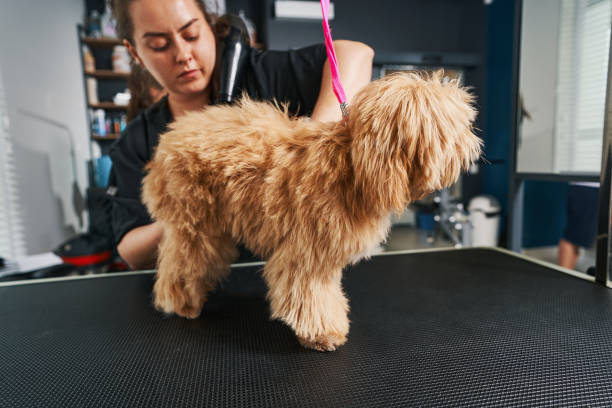How to Brush Dog Hair When They Refuse? Ultimate Guide 2024
Brushing a dog’s hair is crucial for maintaining their health and appearance. It can be frustrating for pet owners when their dogs won’t cooperate during grooming sessions.
This guide provides comprehensive strategies for how to brush dog hair when they refuse. These methods will keep your dog’s coat healthy and tangle-free, even if they resist.
These tips will make the grooming process smoother and more enjoyable for you and your furry friend.
Table of Contents
Understanding Your Dog’s Behavior

Reasons Dogs Refuse Brushing
Dogs may refuse brushing for several reasons, including:
- Fear or anxiety from previous negative experiences.
- Discomfort from the grooming tools.
- Their body is sensitive in certain places.
- Lack of knowledge about grooming.
Identifying Stress Signals
Recognizing stress signals in your dog is essential to address their discomfort promptly. Common signs include:
- Panting and drooling excessively.
- Ears pinned back.
- Tail tucked between the legs.
- Trembling or shaking.
- Attempting to escape or hide.
Preparing for the Brushing Session

Choosing the Right Time and Place
Choose a quiet, comfortable place to groom. Select a time when your dog is calm, like after a walk or playtime, so there are no distractions.
Essential Tools and Supplies
Make sure you have the right tools for your dog’s coat:
- Slicker brush: Great for removing loose hair.
- Pin brush: Good for dogs with long hair.
- Undercoat rake: Effective for double-coated breeds.
- Detangling spray: Helps manage mats and tangles.
Creating a Calm Environment
Play soothing music or use relaxing scents like lavender to create a soothing atmosphere.
Ensure you remain calm and patient, as dogs can sense their owner’s stress.
Techniques for Brushing Uncooperative Dogs
Comfort Building
Introduce your dog to grooming tools gradually. Let them sniff and explore the tools without using them—progress to gentle brushing sessions, starting with short, positive experiences.
Positive Reinforcement Strategies
When you’re brushing your dog, reward him with treats and praise. The grooming process is more enjoyable when positive reinforcement is used.
Handling Nervous or Anxious Dogs
Thundershirts or anxiety wraps gently apply pressure to calm dogs during stressful situations, like grooming.
Thundershirts or anxiety wraps are suitable for particularly nervous dogs. These products provide gentle pressure, which can have a calming effect. Additionally, consult with your veterinarian about possible calming supplements.
Specialized Techniques for Different Coat Types
Short-haired Breeds
Dogs with short hair need regular brushing to remove loose hair and dirt. Using a brush with soft bristles or a grooming glove, brush the hair in the direction it grows.
Long-haired Breeds
Long-haired dogs need to be groomed more often to prevent mats and tangles. Using a slicker brush and detangling spray, begin at the ends of the hair and work your way up.
Curly-haired Breeds
Curly-haired dogs like Poodles need specialized care to maintain their coat. Use a wide-tooth comb and a slicker brush to avoid pulling on the hair.
Double-coated Breeds
Double-coated breeds, like Huskies and German Shepherds, shed a lot. Use an undercoat rake to remove loose undercoat hair and prevent matting.
Dealing with Common Grooming Problems
Mats and Tangles
It’s painful for dogs when they get tangled and matted. Detangling spray and mat splitter will help you work through the tangles. Take your time, and don’t pull dog hair.
Shedding Control
Brushing regularly helps control shedding. You should use a de-shedding tool during heavy shedding seasons.
Sensitive Areas
The belly, ears, and tail of dogs are usually sensitive. Use a softer brush and approach these areas gently, paying attention to your dog’s reactions.
Using Professional Grooming Services

When to Seek Professional Help
Professional grooming services may be necessary if your dog is highly uncooperative or has severe grooming issues.
Professional groomers are trained to handle difficult dogs and can provide your dog’s care.
Finding a Qualified Groomer
Find a groomer with good reviews and certifications. Check if they’ve worked with dogs of your breed and coat type.
Personal recommendations from other pet owners can also be valuable.
What to Expect from a Professional Grooming Session
Typically, a grooming session includes a bath, brushing, nail trimming, ear cleaning, and maybe a haircut.
Communicate your dog’s specific needs and any concerns to the groomer beforehand.
Health Benefits of Regular Brushing
Skin Health
A good brushing stimulates the skin, promoting the production of natural oils that keep the coat healthy. It also removes dead skin cells and prevents clogged pores.
Reducing Allergies
Regular grooming reduces the amount of loose hair and dander, which can help alleviate allergies for you and your dog. In homes with allergy sufferers, this is especially important.
Early Detection of Health Issues
During grooming sessions, you can check for lumps, bumps, or skin issues. Your dog can get quicker treatment and better outcomes if you detect health problems early.
Preventive Measures and Maintenance
Regular Grooming Schedule
Establish a consistent grooming routine based on your dog’s breed and coat type. Regular grooming prevents mats and tangles, reducing the need for more extensive grooming sessions.
Daily Maintenance Tips
Daily maintenance tasks, such as wiping your dog’s paws, brushing their teeth, and checking for ticks, complement regular grooming and keep your dog healthy and clean.
Seasonal Grooming Adjustments
Adjust your grooming routine based on seasonal changes. For example, increase brushing during shedding season and provide additional protection for your dog’s coat in extreme weather conditions.
Conclusion: How to Brush Dog Hair When They Refuse?
Brushing your dog’s hair, even when they refuse, is manageable with the right approach and techniques. Grooming sessions can be smoother and more enjoyable for you and your dog if you understand their behaviour, prepare properly, and use positive reinforcement. Consistent grooming keeps your dog’s coat healthy, strengthens your bond, and allows for early detection of potential health issues. Today, you can implement these strategies to keep your dog happy, healthy, and stylish.







